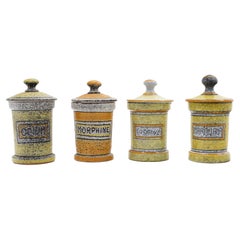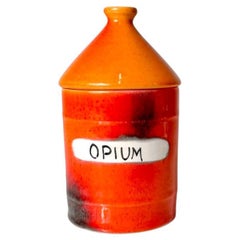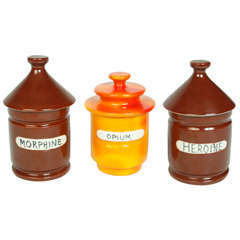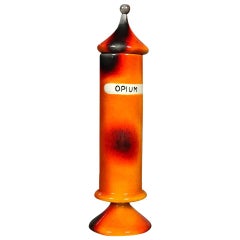Raymor Vice
Vintage 1950s Mid-Century Modern Jars
Pottery
Vintage 1960s Italian Mid-Century Modern Jars
Ceramic
Recent Sales
Vintage 1960s Italian Mid-Century Modern Ceramics
Ceramic
Vintage 1960s Italian Mid-Century Modern Urns
Ceramic, Pottery
Vintage 1960s Italian Mid-Century Modern Tobacco Accessories
Ceramic, Pottery
Vintage 1950s American Mid-Century Modern Jars
Ceramic
Vintage 1950s Italian Mid-Century Modern Ceramics
Ceramic
Vintage 1950s Italian Mid-Century Modern Jars
Ceramic
Vintage 1950s Italian Mid-Century Modern Jars
Ceramic
Vintage 1960s Italian Mid-Century Modern Jars
Ceramic
People Also Browsed
Vintage 1970s American Mid-Century Modern Sectional Sofas
Velvet, Wood
Antique 15th Century and Earlier African Natural Specimens
Bone
21st Century and Contemporary American Modern Barware
Crystal
Mid-20th Century American Tableware
Ceramic
Vintage 1980s American Modern Vases
Ceramic
Early 20th Century Chinese Qing More Asian Art, Objects and Furniture
Brass
2010s American Minimalist Barware
Crystal
Late 20th Century American Mid-Century Modern Ceramics
Ceramic
Vintage 1950s Austrian Mid-Century Modern Chandeliers and Pendants
Brass
Vintage 1950s Finnish Mid-Century Modern Game Tables
Brass
Vintage 1970s Italian Space Age Architectural Elements
Fiberglass
2010s American Organic Modern Vases
Ceramic, Cotton
Vintage 1980s Italian Musical Instruments
Mirror
Antique Early 19th Century English Regency Centerpieces
Ceramic
Vintage 1970s Italian Mid-Century Modern Armchairs
Fabric
Early 20th Century Art Deco Scientific Instruments
Metal, Enamel
Raymor for sale on 1stDibs
Few had their finger on the pulse of American furniture like importer and distributor Raymor. Founder Irving Richards first had his eyes opened to the world of furniture while attending the 1928 Salon d’Automne art and design fair in Paris. He joined Lightolier two years later and developed its business relationships, including with designer Russel Wright.
Wright and Richards met in 1935 and Russel Wright, Inc. was formed in 1936. Its American Modern ceramic tableware, produced under the name Wright Accessories in 1938, was a notably lucrative collaboration. Following the early success of American Modern, Richards obtained the majority share of Wright Accessories and changed its name to Raymor Mfg Division Inc. in 1941.
By 1952, the exclusivity over American Modern had ended (the line was initially produced by Wright Associates and later manufactured by Steubenville for two decades). To keep up with American markets, Raymor worked with prominent designers such as George Nelson, Arthur Umanoff, Ray and Charles Eames, and Hans J. Wegner.
The company’s imports expanded to Denmark, which contributed to the rise of Scandinavian modern designs in the American market. Throughout the 1950s, Richards established relationships with factories in Scandinavia, Italy and Germany, as well as with the influential tastemaker and importer Charles Stendig.
The furniture company Simmons bought Raymor in 1963 and changed its name to Raymor Richards, Morgenthau Inc. in 1969. During that time, Raymor’s Omnibus range of Scandinavian-style wall units became widely popular, along with Italian glass and pottery like Bitossi ceramics designed by Aldo Londi and Bagni ceramics by Alvino Bagni.
Shifting styles coupled with rising competition, and the departure of Richards from the company, ended Raymor. By the late 1970s, Raymor faced a wave of international factories able to produce similar products of lesser quality for a lower cost. Buyers were eager to frequently change their interior styles, limiting the need for high-end, durable furniture, which Raymor had been importing.
On 1stDibs, find a collection of vintage Raymor ceramics, lamps, decorative objects and more.
A Close Look at Mid-century Modern Furniture
Organically shaped, clean-lined and elegantly simple are three terms that well describe vintage mid-century modern furniture. The style, which emerged primarily in the years following World War II, is characterized by pieces that were conceived and made in an energetic, optimistic spirit by creators who believed that good design was an essential part of good living.
ORIGINS OF MID-CENTURY MODERN FURNITURE DESIGN
- Emerged during the mid-20th century
- Informed by European modernism, Bauhaus, International style, Scandinavian modernism and Frank Lloyd Wright’s architecture
- A heyday of innovation in postwar America
- Experimentation with new ideas, new materials and new forms flourished in Scandinavia, Italy, the former Czechoslovakia and elsewhere in Europe
CHARACTERISTICS OF MID-CENTURY MODERN FURNITURE DESIGN
- Simplicity, organic forms, clean lines
- A blend of neutral and bold Pop art colors
- Use of natural and man-made materials — alluring woods such as teak, rosewood and oak; steel, fiberglass and molded plywood
- Light-filled spaces with colorful upholstery
- Glass walls and an emphasis on the outdoors
- Promotion of functionality
MID-CENTURY MODERN FURNITURE DESIGNERS TO KNOW
- Charles and Ray Eames
- Eero Saarinen
- Milo Baughman
- Florence Knoll
- Harry Bertoia
- Isamu Noguchi
- George Nelson
- Danish modernists Hans Wegner and Arne Jacobsen, whose emphasis on natural materials and craftsmanship influenced American designers and vice versa
ICONIC MID-CENTURY MODERN FURNITURE DESIGNS
- Eames lounge chair
- Nelson daybed
- Florence Knoll sofa
- Egg chair
- Womb chair
- Noguchi coffee table
- Barcelona chair
VINTAGE MID-CENTURY MODERN FURNITURE ON 1STDIBS
The mid-century modern era saw leagues of postwar American architects and designers animated by new ideas and new technology. The lean, functionalist International-style architecture of Le Corbusier and Bauhaus eminences Ludwig Mies van der Rohe and Walter Gropius had been promoted in the United States during the 1930s by Philip Johnson and others. New building techniques, such as “post-and-beam” construction, allowed the International-style schemes to be realized on a small scale in open-plan houses with long walls of glass.
Materials developed for wartime use became available for domestic goods and were incorporated into mid-century modern furniture designs. Charles and Ray Eames and Eero Saarinen, who had experimented extensively with molded plywood, eagerly embraced fiberglass for pieces such as the La Chaise and the Womb chair, respectively.
Architect, writer and designer George Nelson created with his team shades for the Bubble lamp using a new translucent polymer skin and, as design director at Herman Miller, recruited the Eameses, Alexander Girard and others for projects at the legendary Michigan furniture manufacturer.
Harry Bertoia and Isamu Noguchi devised chairs and tables built of wire mesh and wire struts. Materials were repurposed too: The Danish-born designer Jens Risom created a line of chairs using surplus parachute straps for webbed seats and backrests.
The Risom lounge chair was among the first pieces of furniture commissioned and produced by celebrated manufacturer Knoll, a chief influencer in the rise of modern design in the United States, thanks to the work of Florence Knoll, the pioneering architect and designer who made the firm a leader in its field. The seating that Knoll created for office spaces — as well as pieces designed by Florence initially for commercial clients — soon became desirable for the home.
As the demand for casual, uncluttered furnishings grew, more mid-century furniture designers caught the spirit.
Classically oriented creators such as Edward Wormley, house designer for Dunbar Inc., offered such pieces as the sinuous Listen to Me chaise; the British expatriate T.H. Robsjohn-Gibbings switched gears, creating items such as the tiered, biomorphic Mesa table. There were Young Turks such as Paul McCobb, who designed holistic groups of sleek, blond wood furniture, and Milo Baughman, who espoused a West Coast aesthetic in minimalist teak dining tables and lushly upholstered chairs and sofas with angular steel frames.
Generations turn over, and mid-century modern remains arguably the most popular style going. As the collection of vintage mid-century modern chairs, dressers, coffee tables and other furniture for the living room, dining room, bedroom and elsewhere on 1stDibs demonstrates, this period saw one of the most delightful and dramatic flowerings of creativity in design history.
Finding the Right Vases-vessels for You
For thousands of years, vases and vessels have had meaningful functional value in civilizations all over the world. In Ancient Greece, ceramic vessels were used for transporting water and dry goods, holding bouquets of flowers, for storage and more. Outside of utilitarian use, in cities such as Athens, vases were a medium for artistic expression — pottery was a canvas for artists to illustrate their cultures’ unique people, beliefs and more. And pottery skills were handed down from fathers to sons.
Every antique and vintage vase and vessel, from decorative Italian urns to French 19th-century Louis XVI–style lidded vases, carries with it a rich, layered story.
On 1stDibs, there is a vast array of vases and vessels in a variety of colors, sizes and shapes. Our collection features vessels made from delicate materials such as ceramic and glass as well as durable materials like rustproof metals and stone.
A contemporary vase can help introduce an air of elegance to your minimalist space while an antique Chinese jar would make a luxurious addition to an Asian-inspired interior. Alternatively, if you’re looking for a statement piece, consider an Art Deco vase crafted by Italian architect and furniture designer Gio Ponti.
Vases and vessels — be they handmade pots, handblown glass wine bottles or otherwise — are versatile, practical decorative objects, and no matter your particular design preferences, furniture style or color scheme, they can add beauty and warmth to any home. Find yours on 1stDibs today.



